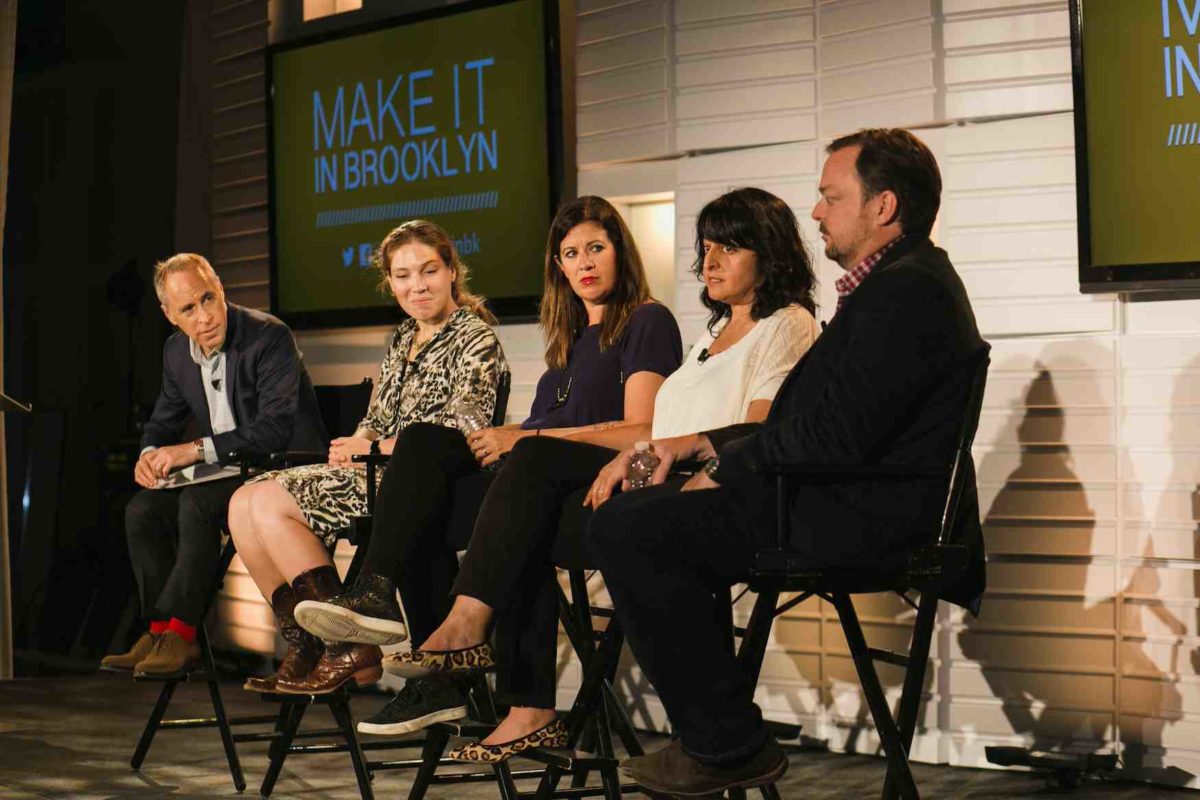“Ten years ago, we wouldn’t have had kale kimchi before we got started here.”
That was the kicker Jacob Weisberg, the publisher of Slate, threw out to close the “Launch. Scale. Thrive.” panel on entrepreneurship at yesterday’s Make It in Brooklyn Innovation Summit hosted by the Downtown Brooklyn Partnership.
On one hand, it’s a well-worn punchline: look at those hipsters and the weird new food trends that pop up in their wake. (Btw, here’s the Indian sauce maker that won the event’s $5,000 pitch competition.) But it also points to how much Brooklyn has changed in the past decade. While some of those changes haven’t been beneficial for all of the borough’s residents — there was a protest right outside the summit’s doors — they’ve undoubtedly brought renewed vitality to its entrepreneurial scene. Brooklyn is now a coveted destination for many businesses, including Slate, which moved to MetroTech earlier this year.
“It used to be that you’d be seen as less legitimate [to be in Brooklyn], but that’s absolutely no longer the case,” said Emily Heyward, a partner at Dumbo branding agency Red Antler. As for the commute to visit clients in Manhattan, she added, “Thank god for the F train.” (That’s perhaps the first time we’ve ever heard that phrase uttered.)
Where they’re going
Another development, as Weisberg pointed out: everyone now wants to launch a startup rather than a small business. So what’s the difference between the two?
Weisberg, who moderated the panel, posed that question to the other panelists, which in addition to Heyward included a trio of folks working in Dumbo: Dana Mauriello, the senior director of wholesale and manufacturing at Etsy; Sherine Kazim, the managing director of experience design at digital agency Huge and Marco Perry, a principal at design consultancy Pensa.
Perry, who shared some of his work hacks with us this summer, summed it up in his characterization of a startup: “You’re going somewhere. It’s not a static business.”
On that note, the panelists dove into the biggest changes and challenges they’ve encountered as their companies have grown. Kazim recounted how Huge, a digital agency, has gradually gotten into the business of tangible products — an approach several agencies have taken as the industry has matured. Having worked with retail clients, the company decided to open a cafe in its Atlanta office to gain firsthand experience with new retail technologies and concepts. More recently, Huge designed the smartphones for LG’s 2017 lineup, as well as the accompanying software and marketing.
“It was a change for us, getting into the physical form of things,” she said. “But we were able to create this amazing, end-to-end, true experience of what a product is.”
All the tech trends
Embracing new technology was a significant theme throughout the panel. But rather than just throwing out flashy buzzwords, the panelists (thankfully) sought to diffuse the hype around them.
Perry seized onto the notion of internet of things. Sure, a smart device such as Nest might be a nifty product, but “it’s still just a thermostat,” he said. In the future, he said, he envisions products that connect with each other to interoperate, rather than be controlled one by one with an app.
“We can’t even imagine where it could go,” he said.
Kazim discussed her fascination with artificial intelligence. It’s been a growing area of interest for Huge, and the company has recently brought on experts in the field to explore its benefits. But it’s not diving headfirst into AI just yet, she said, because many people remain skittish about the concept. (She’s not the only one who’s picked up on this: Google, Facebook, Amazon, IBM and Microsoft just announced a new partnership on AI to better inform a skeptical public.)
“Everything we’ve learned about AI so far is, typically, the robots are trying to kill us,” Kazim said.
Another buzzword that popped up: the maker movement. As we’ve noted, hardware has continued to gain steam in Brooklyn, and the DIY ethos has taken some quirky (maybe even morbid) turns.
When Weisberg questioned whether the movement’s popularity was on the wane, Mauriello quickly countered the notion. The members of Etsy’s community might not call themselves makers, she said, but their interests and principles are similar.
“What people choose to call themselves, I can’t parse out a trend from that,” she said. “We like to use the term ‘creative entrepreneurs’: people who are the designers, who are very intimately involved in the process.”
How Brooklyn could do better
The panelists also had thoughtful recommendations for how the city could encourage continued entrepreneurial growth in Brooklyn. Heyward suggested greater emphasis on design and technology education for all residents to improve diversity in the industry. Perry spoke of alleviating the burden of rapidly increasing real estate prices, which requires companies to steadily increase salaries to attract and keep employees.
“People don’t want to live in squalor,” he said.
Kazim concurred, adding that Huge has fought to keep its Brooklyn employees in one centralized location.
“The minute you’re no longer in the same place, you’re splintering the culture,” she said.
Most intriguing was the input from Mauriello, who described Etsy’s initiatives to influence small-business policy. The company has a policy recommendation team, which recently has focused on areas such as affordable studio space and small-batch manufacturing. One hurdle Etsy’s community members have faced, Mauriello said, is that local small-business agencies often do not understand their needs, which are often quite different than those of traditional brick-and-mortar shops, so the company is working to better communicate their needs to local governments.
Fortunately, though, she added, that’s less of a problem on Etsy’s home turf.
“Brooklyn,” she said, “is certainly ahead of the curve.”







